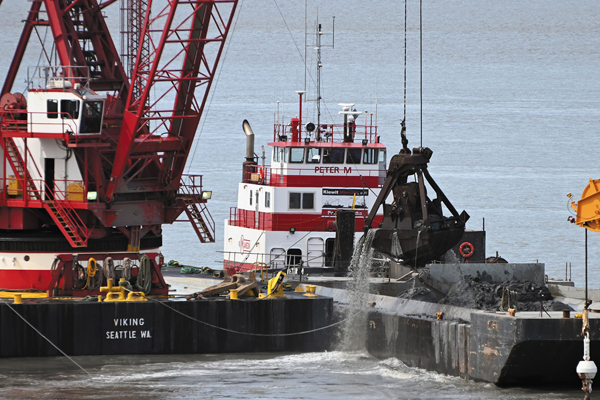Routine, yet never repetitive, dredging operations challenge ports and encourage them to work together, communicate, plan and persevere.

By Sandy Smith
At the Port of Alaska, dredging is an annual occurrence. Under a contract funded by the U.S. Army Corps of Engineers, more than 1 million cubic yards of material is removed from berths each year. While it might seem that routine would lead to some familiar approaches, it is far from that.
Glaciers in the area melt each summer, leaving behind finely ground silt in the Upper Cook Inlet. Then there is the race against the clock; all the material must be dredged before the winter freeze. Add in a high tide that can be as high as 40 feet and the year-round presence of endangered and protected beluga whales.
So when the port began its modernization project, which included dredging to establish the operational depth at the face of the new petroleum and cement terminal (the PCT), the experience with the annual project paid off – but it did not totally mitigate challenges.
“Because of the alignment of the PCT and the requirement of the Corps to have the travel of the dredge kept at a certain angle for efficiency of operations, we had to bring the face of the platform further toward shore,” said Sharen Walsh, P.E., former deputy port director and current modernization program director. “The idea was to bring the projects down to match what the rest of the port is dredged at. That material had never been dredged.”
It made for difficult dredging and some giant boulders. The costs were borne by the port. “It was a full summer of two 12-hour shifts, but we got it done without real incident,” Walsh said.
The first of the five phases, a petroleum and cement terminal, is on track for a ribbon cutting in late 2021. As construction continues and the annual dredging kicks up again in April, it will require a delicate dance and constant communication.
“The interim problem is traffic,” Walsh said. “We have this giant barge putting in pilings for the platform and trestle. That is in the way of the dredging operation. With coordination, we are able to get around most of these issues.”
While each dredging project brings its own unique challenges, especially related to logistics, those who are in the midst of current dredging projects say there are a few ways to mitigate the disruptions and complete the project on time – or even early.
 AAPA Seaports
AAPA Seaports


